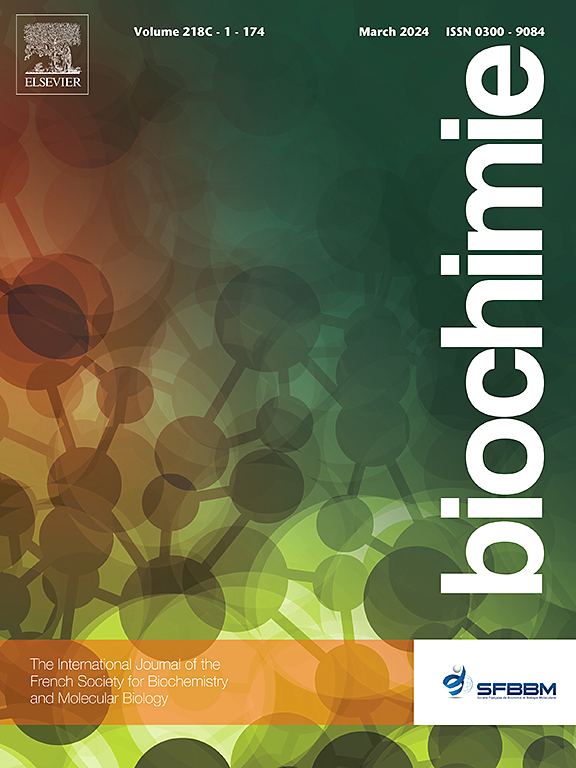巴西利什曼原虫锥虫硫酮还原酶的结构和动力学分析:开发靶向治疗的分子模型。
IF 3
3区 生物学
Q2 BIOCHEMISTRY & MOLECULAR BIOLOGY
引用次数: 0
摘要
本研究探讨了巴西利什曼原虫锥虫硫酮还原酶(LbTR)的重组蛋白表达、纯化和特性,这是一种与皮肤利什曼病有关的必需酶。以大肠杆菌为宿主,成功表达了合成的LbTR基因,随后采用固定化金属亲和层析(IMAC)纯化,得到了20 mg/L的高纯度LbTR,并通过SDS-PAGE和等电聚焦验证。通过综合生化分析确定了重组酶的动力学性质和结构特征。酶分析显示,LbTR有效地降低其天然底物,遵循米切里斯-门腾动力学。结构表征,包括动态光散射和荧光光谱,证实了蛋白质在不同温度下的稳定性和均匀性。圆二色性分析证实存在显著的α-螺旋和β-片状含量,与AlphaFold生成的结构模型一致。采用一微秒内的分子动力学模拟研究了LbTR在天然同二聚体形式下与必需辅因子和底物络合的构象动力学。这些模拟的结果为酶的结构行为和催化机制提供了有价值的见解,强调了它作为治疗利什曼病的靶点的潜力。本文章由计算机程序翻译,如有差异,请以英文原文为准。
Structural and kinetic profiling of Leishmania braziliensis trypanothione reductase: A molecular model for the development of targeted therapies
This study explores the recombinant protein expression, purification, and characterization of Leishmania braziliensis Trypanothione Reductase (LbTR), an essential enzyme implicated in cutaneous leishmaniasis. Using E. coli as the host organism, the synthetic gene encoding LbTR was successfully expressed and subsequently purified using Immobilized Metal Affinity Chromatography (IMAC) yielding 20 mg/L of highly pure LbTR, verified by SDS-PAGE and isoelectric focusing. Comprehensive biochemical analyses were conducted to determine the recombinant enzyme's kinetic properties and structural features. Enzymatic assays revealed that LbTR efficiently reduces its natural substrate, following Michaelis-Menten kinetics. Structural characterization, including dynamic light scattering and fluorescence spectroscopy, confirmed the protein's stability and homogeneity in solution under varying temperatures. Circular dichroism analysis corroborated the presence of significant α-helical and β-sheet content, aligning with the structural model generated with AlphaFold. Molecular dynamics simulations over 1 μs were employed to investigate the conformational dynamics of LbTR in its native homodimeric form, complexed with essential cofactors and substrates. The results from these simulations offer valuable insights into the enzyme's structural behavior and catalytic mechanism, underscoring its potential as a target for therapeutic development against leishmaniasis.
求助全文
通过发布文献求助,成功后即可免费获取论文全文。
去求助
来源期刊

Biochimie
生物-生化与分子生物学
CiteScore
7.20
自引率
2.60%
发文量
219
审稿时长
40 days
期刊介绍:
Biochimie publishes original research articles, short communications, review articles, graphical reviews, mini-reviews, and hypotheses in the broad areas of biology, including biochemistry, enzymology, molecular and cell biology, metabolic regulation, genetics, immunology, microbiology, structural biology, genomics, proteomics, and molecular mechanisms of disease. Biochimie publishes exclusively in English.
Articles are subject to peer review, and must satisfy the requirements of originality, high scientific integrity and general interest to a broad range of readers. Submissions that are judged to be of sound scientific and technical quality but do not fully satisfy the requirements for publication in Biochimie may benefit from a transfer service to a more suitable journal within the same subject area.
 求助内容:
求助内容: 应助结果提醒方式:
应助结果提醒方式:


